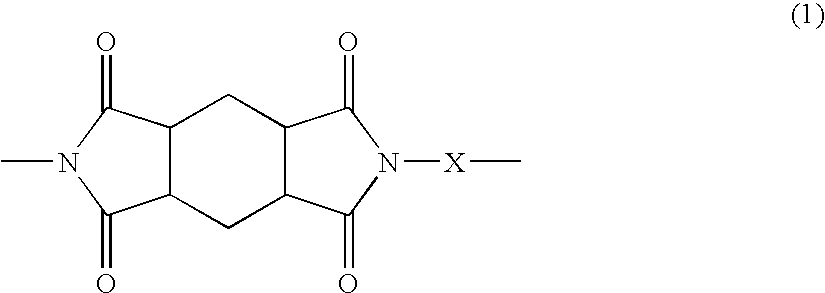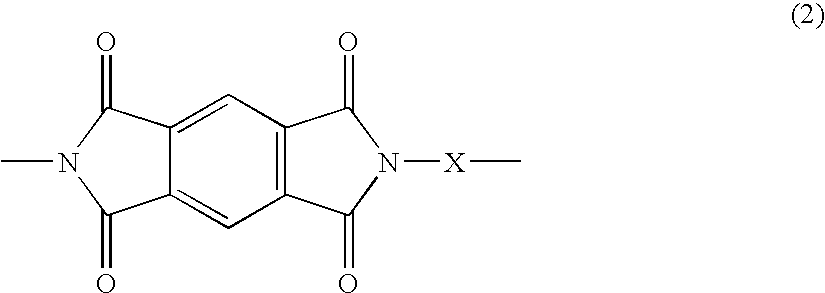Thermocurable Polyimide Resin Composition
- Summary
- Abstract
- Description
- Claims
- Application Information
AI Technical Summary
Benefits of technology
Problems solved by technology
Method used
Image
Examples
synthesis example 1
[0096]In a 300-mL five-necked glass-made round bottom flask which was provided with a Dean-Stark equipped with a stainless steel-made semicircular stirring blade, a nitrogen introducing tube and a cooling tube, a thermometer and a glass-made end cap, 27.43 g (0.06682 moles) of 2,2-bis[4-(4-aminophenoxy)phenyl]propane (BAPP, manufactured by Wakayama Seika Kogyo Co., Ltd.), 50.89 g of γ-butyrolactone (GBL, manufactured by Mitsubishi Chemical Corporation) and 0.34 g of triethylamine (TEA, manufactured by Kanto Chemical Co., Inc.) as a catalyst were stirred under a nitrogen atmosphere at 100 rpm, thereby obtaining a solution.
[0097]14.98 g (0.06682 moles) of 1,2,4,5-cyclohexanetetracarboxylic dianhydride (HPMDA, manufactured by Mitsubishi Gas Chemical Company, Inc.) and 12.72 g of N,N-dimethylacetamide (DMAC, manufactured by Mitsubishi Gas Chemical Company, Inc.) were collectively added thereto, respectively, and the mixture was then heated by a mantle heater, thereby raising the tempera...
synthesis example 2
[0100]In the same five-necked glass-made round bottom flask as that used in Synthesis Example 1, 26.48 g (0.07187 moles) of 4,4′-bis(4-aminophenoxy)biphenyl (BAPB, manufactured by Wakayama Seika Kogyo Co., Ltd.), 51.11 g of GBL and 0.36 g of TEA as a catalyst were stirred under a nitrogen atmosphere at 100 rpm, thereby obtaining a solution.
[0101]16.11 g (0.07187 moles) of HPMDA and 12.78 g of DMAC were collectively added thereto, respectively, and the mixture was then heated by a mantle heater, thereby raising the temperature within the reaction system to 10° C. over about 20 minutes. The temperature within the reaction system was kept at 180° C. for 3.5 hours while collecting a component to be distilled off.
[0102]After adding 96.11 g of DMAC, the mixture was stirred at a temperature in the vicinity of 130° C. for about 30 minutes, thereby forming a uniform solution, which was then cooled to 100° C. over about 10 minutes. There was thus obtained a polyimide resin solution having a s...
synthesis example 3
[0104]In the same five-necked glass-made round bottom flask as that used in Synthesis Example 1, 25.87 g (0.06302 moles) of BAPP, 0.95 g (0.00700 moles) of m-xylylenediamine (MXDA, manufactured by Mitsubishi Gas Chemical Company, Inc.), 50.00 g of N-methyl-2-pyrrolidone (NMP, manufactured by Mitsubishi Chemical Corporation) and 0.35 g of TEA as a catalyst were stirred under a nitrogen atmosphere at 100 rpm, thereby obtaining a solution.
[0105]15.70 g (0.07002 moles) of HPMDA and 13.79 g of NMP were collectively added thereto, respectively, and the mixture was then heated by a mantle heater, thereby raising the temperature within the reaction system to 200° C. over about 20 minutes. The temperature within the reaction system was kept at 200° C. for 5 hours while collecting a component to be distilled off.
[0106]After adding 96.21 g of DMAC, the mixture was stirred at a temperature in the vicinity of 130° C. for about 30 minutes, thereby forming a uniform solution, which was then cooled...
PUM
| Property | Measurement | Unit |
|---|---|---|
| Temperature | aaaaa | aaaaa |
| Temperature | aaaaa | aaaaa |
| Temperature | aaaaa | aaaaa |
Abstract
Description
Claims
Application Information
 Login to View More
Login to View More - R&D
- Intellectual Property
- Life Sciences
- Materials
- Tech Scout
- Unparalleled Data Quality
- Higher Quality Content
- 60% Fewer Hallucinations
Browse by: Latest US Patents, China's latest patents, Technical Efficacy Thesaurus, Application Domain, Technology Topic, Popular Technical Reports.
© 2025 PatSnap. All rights reserved.Legal|Privacy policy|Modern Slavery Act Transparency Statement|Sitemap|About US| Contact US: help@patsnap.com



